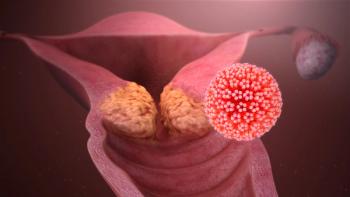
HPV Triage After Abnormal Cervical Cytology Detects CIN Earlier
Women who undergo HPV testing following a test showing abnormal cytology have earlier detection of high-grade cervical intraepithelial neoplasia, compared to those who do not undergo HPV testing.
Women who undergo human papillomavirus (HPV) testing following a test showing abnormal cytology have earlier detection of high-grade cervical intraepithelial neoplasia (CIN), compared to those who do not undergo HPV testing, according to a new study. The higher rates of detection come at the expense of increased biopsy and electrosurgical excision rates.
“There has been much interest in the use of HPV testing to guide the management of women with low-grade cervical cytology test results,” wrote study authors led by Jay Cuzick, PhD, of Queen Mary University of London. “Although widely used for several years in the United States, where the cross-sectional predictive value of a positive HPV test result for CIN grade 2 or more severe (CIN2+ or CIN3+) is well established, less is known about the long-term influence of routine HPV triage on disease detection and clinical management.”
The new study included 20,677 women in New Mexico, out of a total of 457,317 screened, whose first cytology results were reported as atypical squamous cells of undetermined significance (ASC-US). The mean age of the entire screening cohort was 39.8 years. Results of the analysis of these women were
Of those with an ASC-US result, 80.5% had an HPV test either as a co-test or as a triage test within 28 days of the cytology result; because 15.6% of women with a normal cytology result also had a co-test, the investigators determined that 64.9% of the 20,677 women were tested for triage for their ASC-US result. Of women who had an HPV test, 43.1% were positive.
At 5 years, CIN3+ was detected in 2.49% of women with HPV testing, compared with 2.15% of women without HPV testing, for a relative risk of 1.16 (95% CI, 0.92–1.45; P = .23); the time to CIN3+ detection was significantly shorter in those with HPV testing, at 103 days compared with 393 days without HPV testing (P < .001).
CIN grade 1 was found in 11.6% of those with HPV testing, compared with 6.6% of those without it, for a relative risk of 1.76 (95% CI, 1.56–2.00; P < .001). For CIN2, the 5-year rate was 4.3% with HPV testing and 3.4% without, for a relative risk of 1.27 (95% CI, 1.06–1.53; P = .008). Again, the time to diagnosis of CIN2 was substantially shorter with HPV testing.
More women who underwent HPV testing underwent at least one biopsy or endocervical curettage; 32.1% of those tested had at least one biopsy within 5 years, compared with 20.6% of those without HPV testing (P < .001). Loop electrosurgical excision rates within 5 years were 20% higher in those who underwent HPV testing.
“It is clear from this study and elsewhere that almost all of the high-grade disease in women with ASC-US cytology is associated with HPV positivity and that HPV testing leads to earlier detection and treatment of disease,” the authors wrote. “A full economic evaluation of the costs and benefits of HPV triage based on a large cohort is desirable.”
Newsletter
Stay up to date on recent advances in the multidisciplinary approach to cancer.



















































































